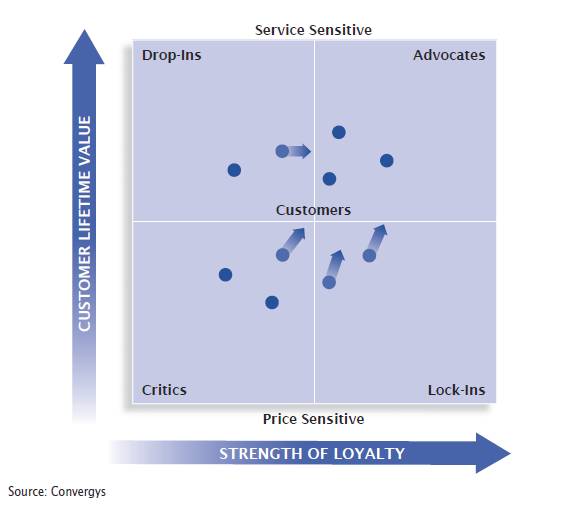Anyone who has ever taken a business or economics course will attest to the fondness of academics for a 2×2 matrix. Put one variable on the X axis, another on the Y, and presto – all manner of phenomenon can be explained. It’s a clarifying and therefore tempting tool – and can be applied to customer experience marketing, too. For example, Stan Phelps refers to a “Value / Maintenance Matrix” in his Marketing Lagniappe blogs (http://bit.ly/n6jN1h). The coveted second quadrant is populated by customers who are high value and low maintenance. This reminded me of the Loyalty Model I developed last year, which plots customers by their lifetime value and strength of loyalty.
According to the research I directed (http://bit.ly/oDzXg8), 89 percent of customers will say they are loyal, but only 29 percent of those customers then add that they would remain loyal after a bad experience with a company. And when it comes to what they do in practice, only 10 percent say they remained loyal after actually having a bad experience. In other words, 9 out of 10 customers who see themselves as loyal are not willing to give companies a second chance when there is a problem. Loyalty needs to be earned constantly, in every interaction—and it can evaporate with one bad experience.
Customers are not all alike, of course, and the research found that they can actually be
plotted into a 2×2 matrix based on their degree of loyalty, or how likely they are to stay with a company, and their value to the organization. When these factors are plotted, customers fall into four distinct segments (see diagram):
- Critics: Customers who are low-value, and demonstrate low levels of loyalty. They may need something the company provides, but may not be satisfied with the customer experience. Often, they are more than willing to leave whenever an alternative is available.
- Lock-Ins: Customers who are low-value, with moderate to high levels of loyalty. They typically stay with a company for some time, but they don’t spend much. They may be relatively satisfied, or they may be locked in through a contractual relationship or because of the costs of switching from one organization to another. But companies are not getting is a share of their heart or enthusiasm.
- Drop-Ins: Customers who are relatively high-value, but also relatively fickle. They may actually be making significant purchases from the company, but will easily move to a competitor. They may be very valuable customers, but they are not valuable just to you.
- Advocates: The 15 percent of customers who are high value “super loyalists.” This group does in fact behave the way companies traditionally expect loyal customers to behave. Compared to the other 85 percent of consumers, Advocates tend to make more frequent purchases of a company’s products or services, recommend the company to friends and family, and avoid shopping at competitor companies. Advocates are 22 percent more likely to purchase bundled products, 28 percent more likely to anticipate increased spending with the company in the near future, and 25 percent more receptive to information about new or upgraded products.

Advocates as a group are valuable in their own right. But they also hold the key to new customer experience strategies that can drive increased customer loyalty across the customer base. Advocates expect superior service, such as easy access to live agents, and generally respond with increased spend. Additionally, Advocates tend to be more open than others to proactive communications. You can learn from their service, product and rewards preferences in order to design programs that fit the needs and value of the other segments. Well-designed segmented programs can migrate other customers towards Quadrant 2, turning them into Advocates with greater loyalty and value.
The Loyalty Model encourages companies to provide the right differentiated service
to different segments according to their value and stickiness. Building on this kind of foundation, companies can continuously hone the customer experience. Staying in step with your best, super-loyal customers, and learning from them, will be key to keeping customers and building lasting, profitable relationships. Not a bad result from a little structured thinking!




Great insights! Loyalty is a key to any company’s success. Those that earn it tend to soar. Here is one of my favorite videos offering advice on how to make it happen – http://www.upyourservice.com/video-theater/how-do-you-build-and-sustain-a-superior-service-culture